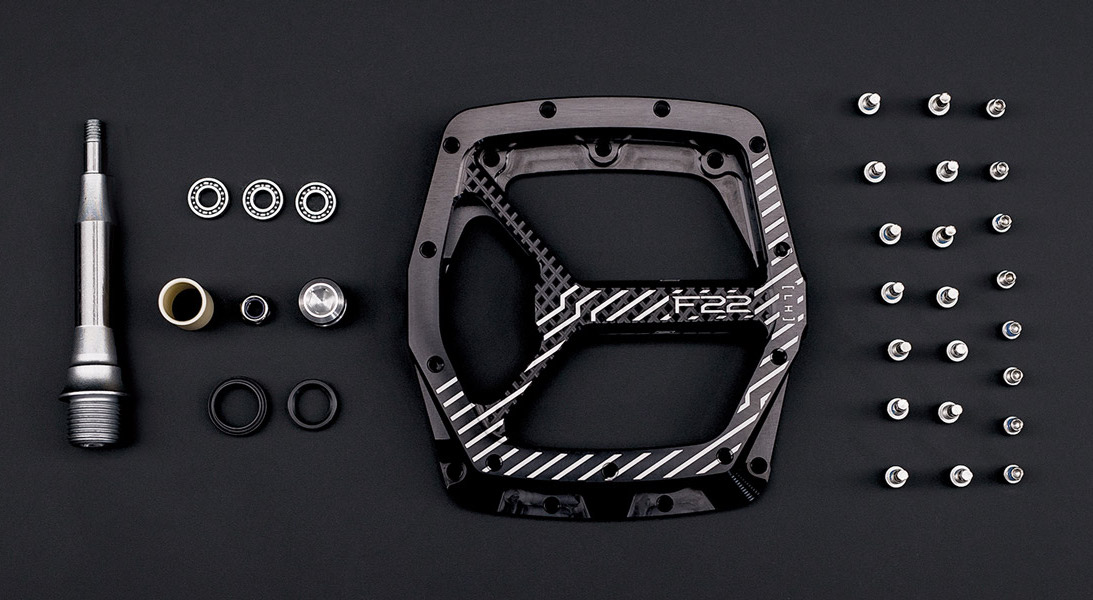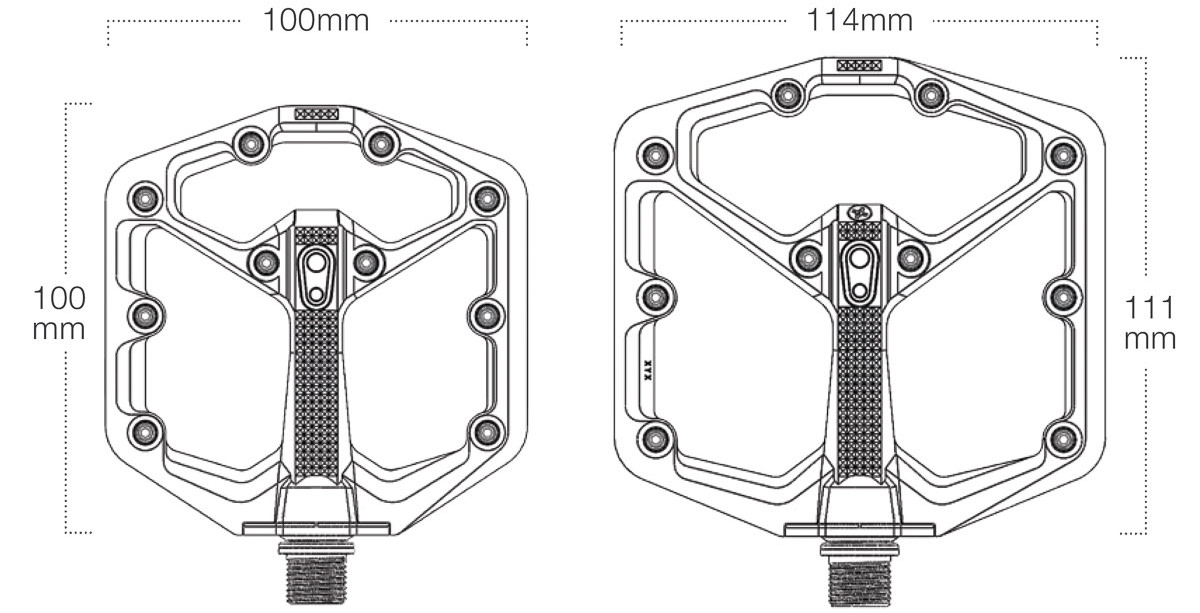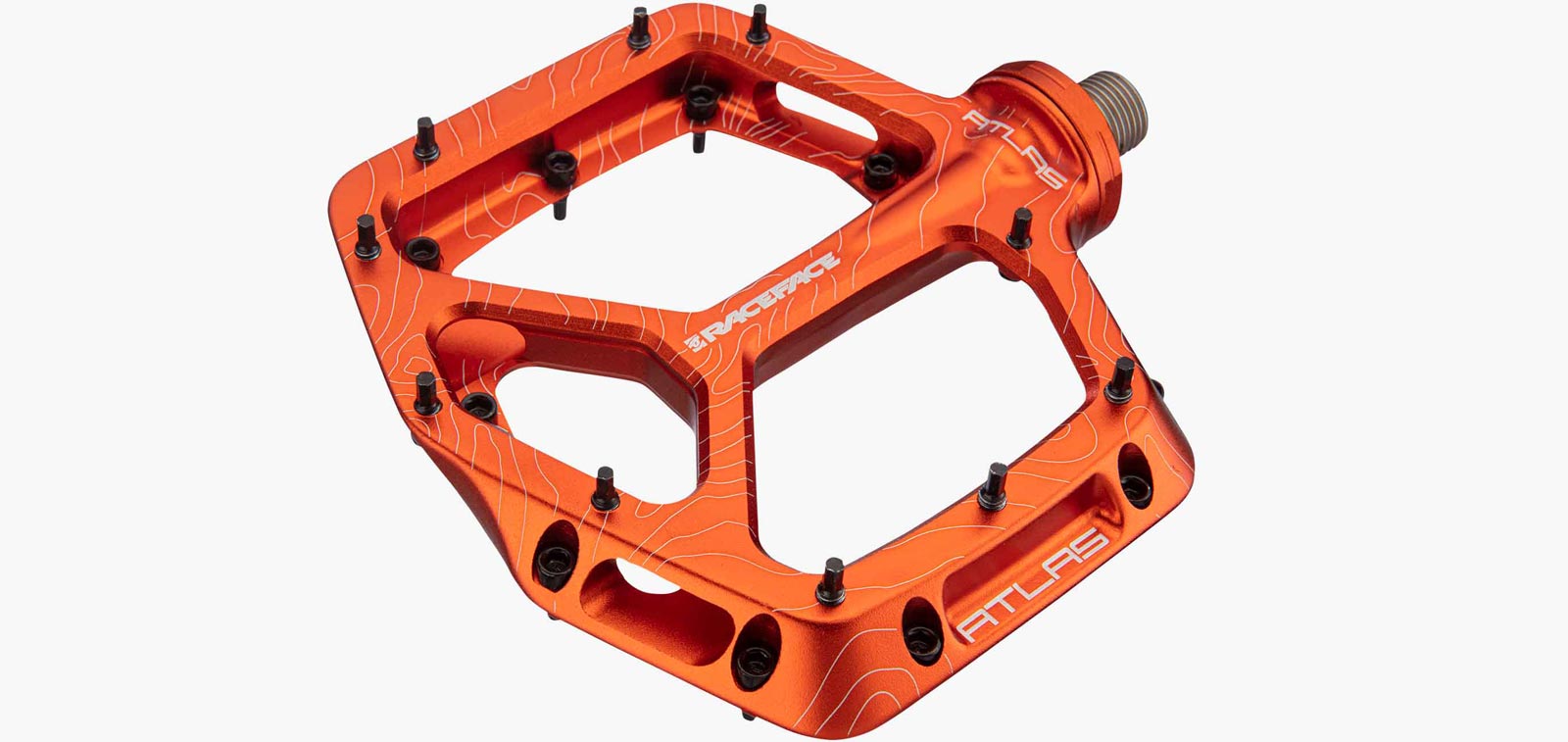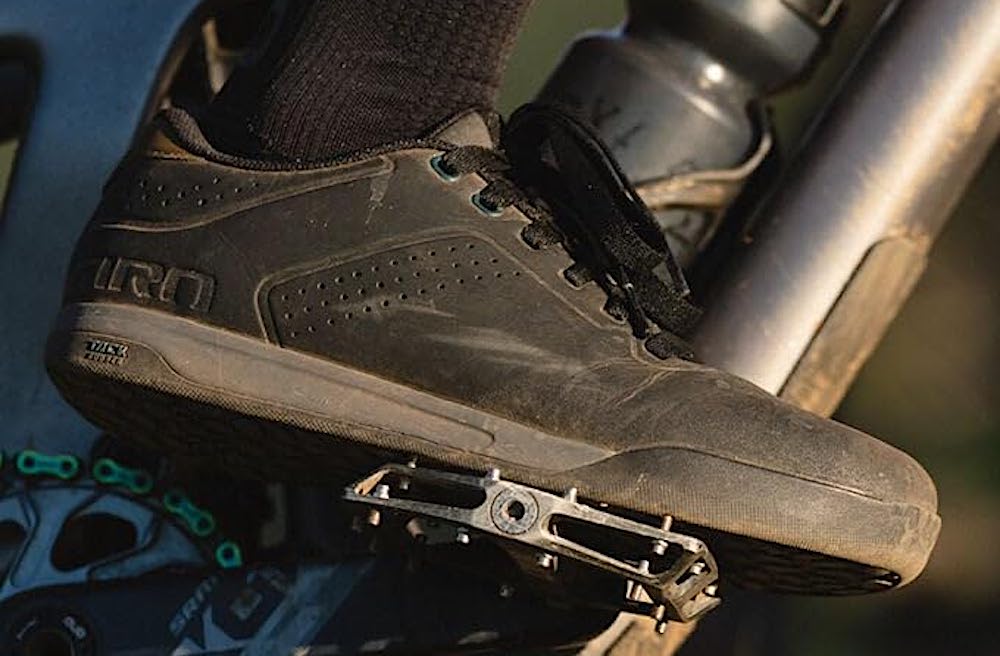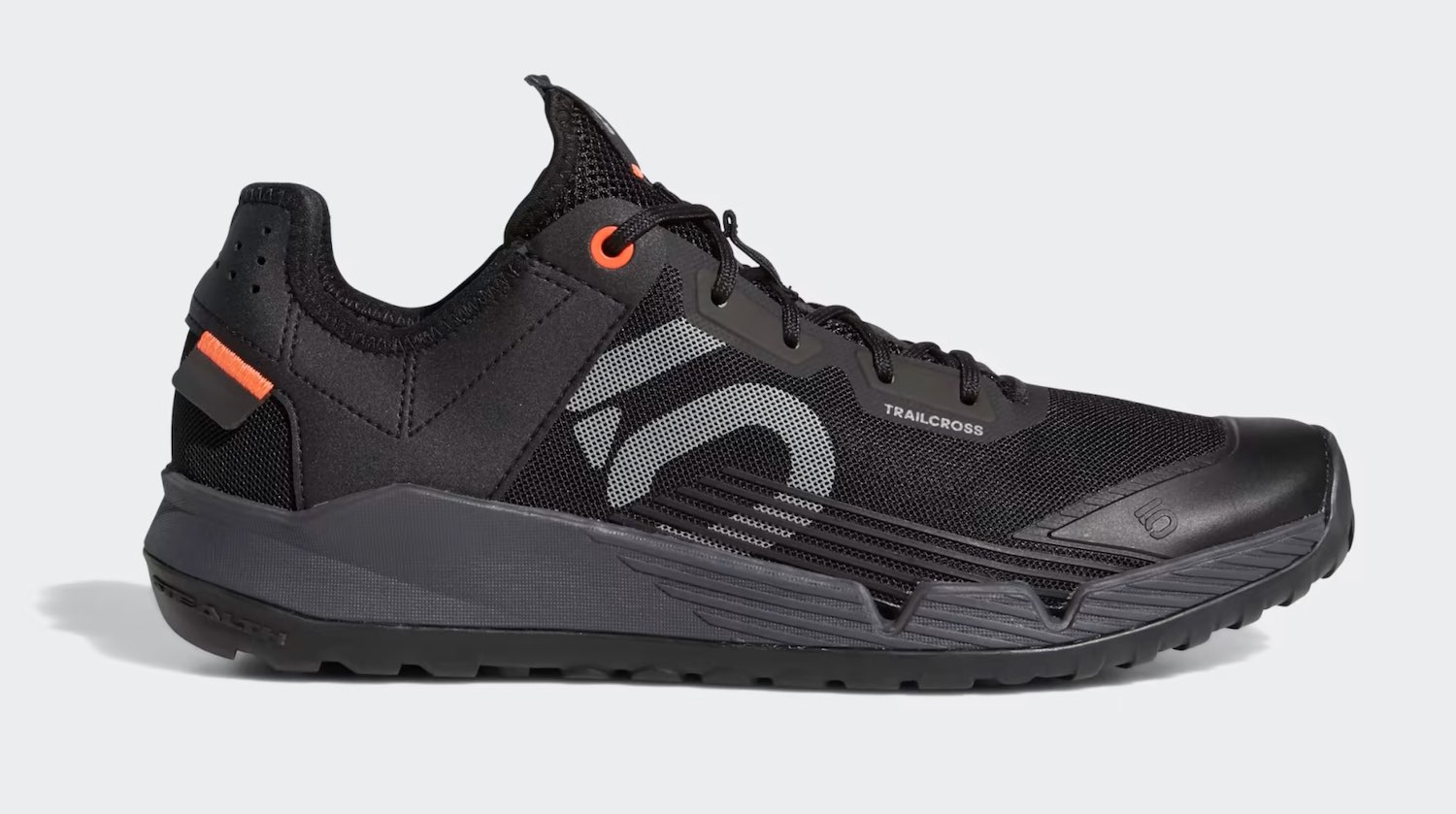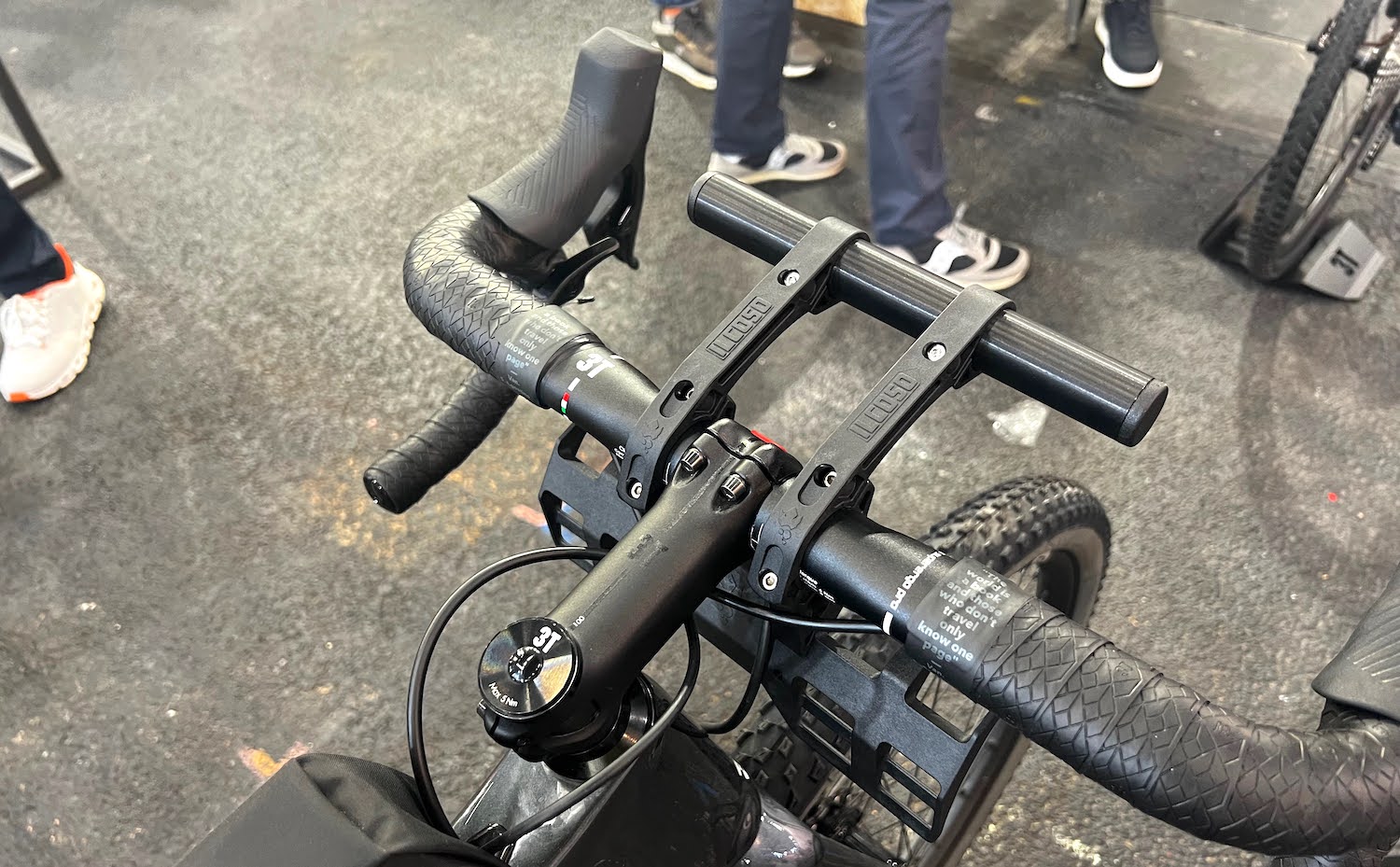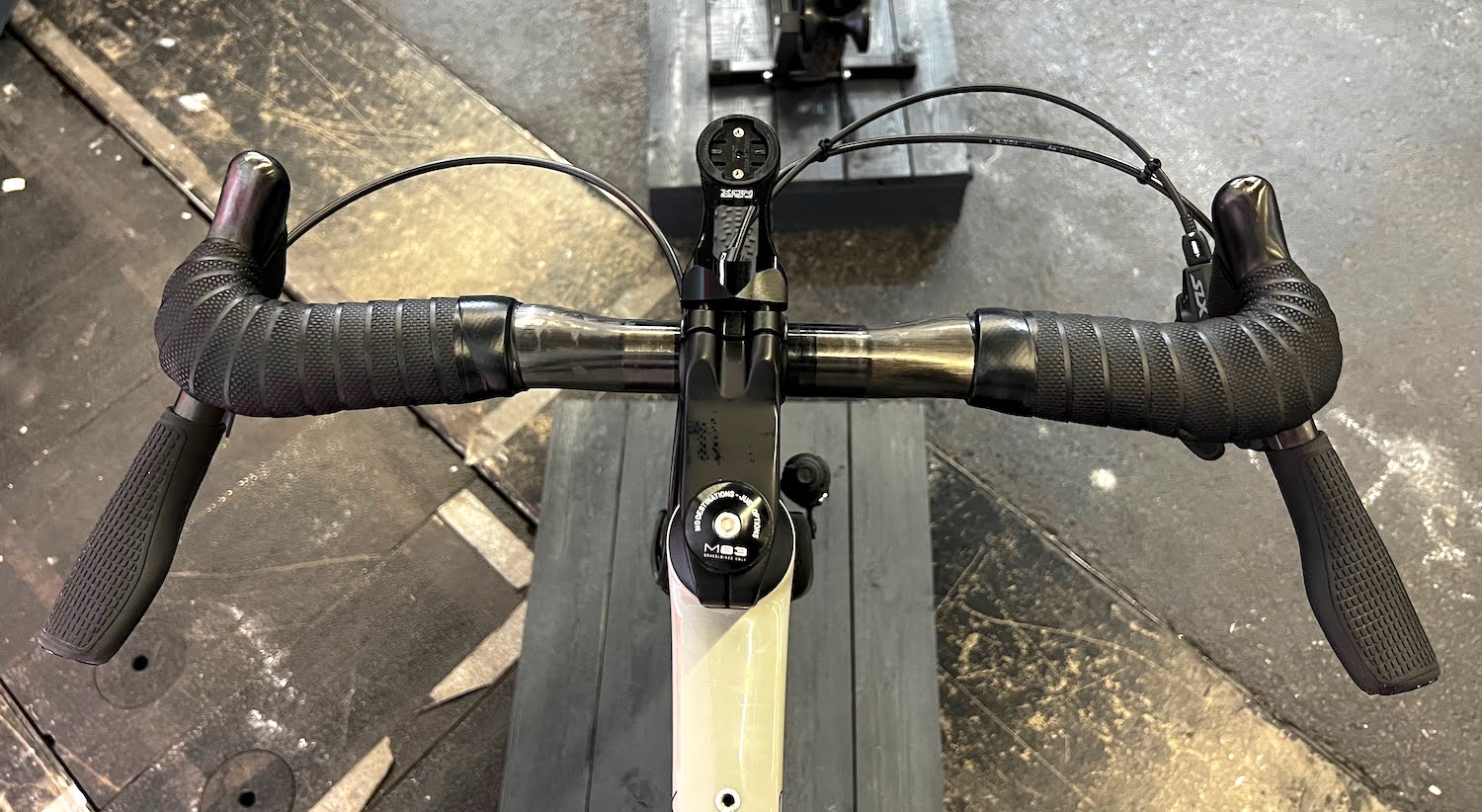Table of Contents
While the shoe is arguably the most important component of a clip-in system, it’s the pedal that makes the biggest difference when it comes to optimising the best flat pedal system.
In this resource, I’ll be teaching you everything about flat pedal shape, size, pins, bearings, and much more.
You will be able to apply my recommendations for on-road cycling where extreme grip is not as important as comfort and user-friendliness. There will be ample information about pedals for off-road use too.
I’ve also included some notes about flat pedal shoes, as the right type of sole makes a big difference in both the comfort and foot support you will experience.
Let’s get into it!
Flat Pedal Thicknesses
Thinner flat pedals are often preferred because they offer a lower stack height. This not only significantly reduces the frequency of pedal strikes with the ground, but it makes you feel a bit more connected to your bike. The Crank Brothers pedals shown above have one of the lowest stack heights available (11mm).
However, the downside to thin flat pedals is that they often use smaller bearings that reduce the overall durability.
Crank Brother Stamp 7
Thin body pedals that run on bushings.
SM: 100mm x 100mm x 11 mm, 345g / 12.2oz
LG: 114mm x 111mm x 11 mm, 375g / 13.2oz
Flat Pedal Shapes
When you look at flat pedals from the side you’ll notice a cool feature – most have offset platforms. This offset creates a slope on the front face that brushes over obstacles (like rocks and curbs) rather than hitting them squarely and incidentally throwing you over the bars.
A key thing to look out for in a pedal design is the concavity of the platform (it can also be a large-stepped surface). A concave-shaped pedal can boast comfort and grip in equal measure, and you will not need to rely on tall pins to generate all of your grip. Look out for pedals with 2mm or more concavity.
And lastly, avoid pedals with thick axle bumps as they can be significantly less grippy and very uncomfortable.
Raceface Atlas
Thin concave body pedals with large inboard bearings.
110 x 108 x 12 mm
386g / 13.6oz
MKS Allways
Thicker concave body pedals with sealed bearings and stubby pins.
110mm x 84mm x 18 mm
381g / 13.4oz
Flat Pedal Platform Sizes
A wider platform than the width of your shoe and the pins won’t end up in the right place. A platform smaller than your shoes and you won’t have the optimal grip.
The general consensus is that platform dimensions less than 100 x 100mm are considered small, and greater than 110 x 100mm are considered large. If your foot is a Men’s US 8 (EU40) shoe size or smaller, pedals labeled as small may be all you need.
I recommend trying some of the longer pedals rather than the shorter ones to give your foot a little bit more space to maneuver.
A particularly long pedal that’s used by many who claim less foot fatigue and increased bike control is the Pedaling Innovations Catalyst.
Pedaling Innovations Catalyst Evo
Biggest platform pedal available.
143mm x 95mm x 16 mm
510g / 18oz
Flat Pedals With Pins
A good set of pins makes for a secure connection that will rival a good clip-in pedal.
One of the best pin designs I’ve seen is on the Hope F22 pedals. They feature adjustable bottom-loading pins, with taller hex-shaped pins on the edges, and shorter stubbier pins on the sides. Together with the 1.5mm concave depression in the center of the pedal, they offer a grippy, yet comfortable place for your foot.
Bottom-loading pins are usually the easiest to remove since the tool head of the pin is not exposed to the elements. Bottom-loading varieties sometimes even come with washers to tailor the pin height to your personal preference.
Some pedals come with low-profile pins from the factory, which may be sufficient on more mellow trails.
Hope F22
Varying size pins and washers.
106 mm x 103 mm x 14mm
360g / 12.7oz
Shimano XT 8140
Available with low-profile pins.
SM: 100 mm x 105 mm x 17 mm, 460g / 16.2oz
LG: 110 mm x 115 mm x 17 mm, 505g / 17.8oz
Flat Pedals Without Pins
If you’re scared of pins puncturing your shins, there are plenty of options catered to casual or touring cyclists. The Shimano EF-202 is my favourite. I’ve put a lot of people on these pedals and they are all very happy.
The Look Geo Trekking, with its many versions, is another interesting option. It uses an injection-molded body with a concave surface and no pins whatsoever. If you like wearing flip-flops (or even barefoot), these may be the ticket.
Shimano PD-EF-202
My favourite pinless pedals (alloy) with lightly serrated ridges.
101 x 101 x 18 mm
512g / 18.1oz
Look Geo City
Large pinless nylon pedals primarily for urban use.
110 x 107 x 16 mm
330g / 11.6oz
Flat Pedal Bearing and Seals
Thicker pedals generally house the largest and most durable bearings. However, some thinner pedals, like the Raceface Atlas, use an alternative design with a larger bearing close to the crankset. This design allows the pedal body to be very slim, while still affording good bearing durability.
The downside may be that this raised section of the pedal might force your foot outboard, increasing your Q-factor (the distance between pedal platforms on either side of the crankset).
High-quality pedals often include a type of glide bushing. These bearings can be very effective in offsetting the side loads that often result in premature wear on regular cartridge bearings.
Most pedals use a wiper or labyrinth seal to keep dust and water out, however, I’ve found that’s with varying levels of success. Not many of the pedals I’ve used escaped periodic maintenance (yearly) and some affordable pedals (<$50 pedals) even needed to be fully replaced after that time.
Some pedals use cup and cone bearings (Shimano) that can be overhauled periodically to prolong their lifespan. In comparison, the tiny sealed cartridge bearings found on many pedals usually need to be replaced more often.
Flat Pedal Construction Materials

You can choose between affordable nylon pedals (they’re actually very pleasant to use) and slightly more durable alloy pedals. Both are often available in a range of dyed or anodized colors.
While I personally prefer the look and feel of aluminum body pedals, there are lots of injection-molded pedals that are well worth considering. They’re almost always lighter and quite a bit cheaper than the CNC-machined alloy ones. And in use, you’d be hard-pressed to tell the difference.
Raceface Chester
Tried and tested nylon pedal, also available in alloy.
110mm x 101mm x 18.4 mm
360g / 12.7oz
Shimano GR-400
An excellent nylon pedal from Shimano.
101mm x 96mm x 16 mm
394g / 13.9oz
Flat Pedal Axle Materials
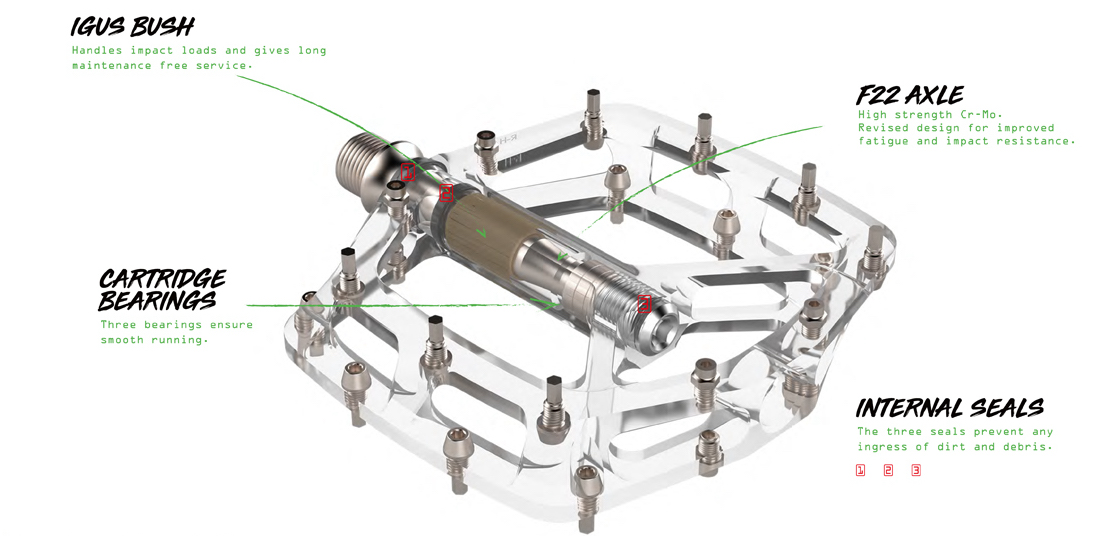
High-quality axle materials increase durability too, as they are less likely to corrode and are machined to closer tolerances. Look out for axles in chromoly, stainless steel, or even titanium. Although, please note that titanium axles sometimes come with a weight restriction.
How To Choose Your Flat Pedal Shoes
Here’s the best thing – you can use any footwear you like! Well, as long as it has an entirely flat sole.
Most cycling-specific MTB shoes use a combination of soft durometer rubber (around 50c) and a grid of shallow lugs to allow the pins to maximize traction. Some shoes have a slightly stiffer midsole, increasing efficiency and providing a bit more support.
The front of a flat pedal shoe is usually more flexible than a clip-in shoe, which makes them more comfortable to walk in, especially uphill during inadvertent hike-a-bike moments.
Russ from Path Less Pedaled has good videos on alternative cycling shoes. His suggestions range from trail running shoes to casual shoes from Giro and Pearl Izumi. I like Russ’s YouTube channel as he recommends people take on a casual style of riding that prioritizes comfort and enjoyment rather than gains and efficiency.
My Shoes of Choice
The flat pedal shoes I’ve landed on are the Five Ten Trailcross LT. I’ve now had three pairs. I find them so comfortable to walk in that they are my everyday shoes.
The great thing about the Trailcross LTs is that the upper is largely constructed out of mesh material, which ventilates exceptionally. And the gel pads around the ankle make for a comfortable and secure fit while giving a very unrestricted feel.
When I’ve used these shoes in the pouring rain, they’ve always dried quickly. I find the combination of breathable shoes + waterproof socks (Sealskins) to be better than dedicated waterproof shoes, as they work out to be lighter, better ventilated, and more versatile.
You can find the Five Ten Trailcross LT shoes on Amazon HERE.
The Best Flat Pedals Overall
It’s hard to narrow it down to so few but the Hope F22 pedals tick so many boxes for off-road use.
The quality of manufacturing, excellent body shape, triple cartridge bearings, and seal arrangement are real standouts. The bottom-loading pins are easy to replace, and the pin length is adjustable with washers. The Hope F22 pedal is fully serviceable and rebuildable, and lightweight to boot (360g / 12.7oz)
Yes, these pedals are very expensive (US $183/£145/€180), especially compared to composite alternatives. They also don’t have the biggest pedal platform available (106 mm x 103 mm) or the most concave shape.
But their all-round quality is nothing short of amazing – expect them to last longer than everything else.
If you are on a budget, the Raceface Chester pedals are available for under US $50.
These large nylon pedals (110mm x 101mm) feature well-sealed cartridge bearings, bottom-loading hex pins, and a nice concave design. The bearing and bushing system is 100% serviceable too.
They are backed up with a two-year manufacturer warranty and are available in nine colours, including hot pink!
You can find the Raceface Chester pedals on Amazon HERE.
The MKS Allways is a particularly nice pedal for moderately rough terrain (think gravel up to 4×4 tracks).
They feature smooth cartridge bearings, nicely finished bodies, and a unique and elegant design. The platform is slightly concave to prevent your feet from slipping, and the stubbier removable pins are significantly less aggressive than what you’ll find on a ‘proper’ off-road pedal.
The Allways are a bit chunky (18mm thick) but they are long enough (110mm) to move your feet around. At US $75 they are reasonably priced for an alloy pedal.
And lastly, if you’re riding on smoother terrain, the Shimano EF-202 pedals are undoubtedly the best pinless design available. They feature a notably large platform (101 x 101 x 18 mm) and lightly serrated edges to cup your feet nicely.
You can expect no punctured shins or calves with these pedals, and at US $40 they are a relative bargain.
You can find the Shimano EF-202 pedals on Amazon HERE.
Summary
In a nutshell:
– Look out for pedals with some concavity.
– Determine whether a thin pedal is necessary on your bike.
– Pick a platform size that best suits your shoe size.
– Look to thicker pedals for the largest and most durable bearings.
– Find a pin design that allows for height adjustment and replacement (they will eventually get damaged).
– Avoid pedals with thick axle bumps.
Providing these factors are in place, it’s pretty much up to you if you want to spend more money on fancy materials which may improve their lifespan.
Remember that pinless flat pedals may not provide heaps of grip, but can still be very adequate and comfortable options that may ease you into this style of riding.
And finally, a dedicated flat pedal shoe with a sturdy, grippy sole will provide the best possible pedal traction.
Find out why flat pedals are better than clip-in pedals for most people in my resource HERE.

